
The Iraqi no-fly zones conflict was a low-level conflict in the two no-fly zones (NFZs) in Iraq that were proclaimed by the United States, United Kingdom, and France after the Gulf War of 1991. The United States stated that the NFZs were intended to protect the ethnic Kurdish minority in northern Iraq and Shiite Muslims in the south. Iraqi aircraft were forbidden from flying inside the zones. The policy was enforced by the United States and the United Kingdom until 2003, when it was rendered obsolete by the 2003 invasion of Iraq. French aircraft patrols also participated until France withdrew in 1996.
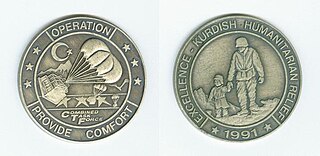
Operation Provide Comfort and Provide Comfort II were military operations initiated by the United States and other Coalition nations of the Persian Gulf War, starting in April 1991, to defend Kurdish refugees fleeing their homes in northern Iraq in the aftermath of the Gulf War, and to deliver humanitarian aid to them. The no-fly zone instituted to help bring this about would become one of the main factors allowing the development of the autonomous Kurdistan Region.

The McDonnell DouglasF-15E Strike Eagle is an American all-weather multirole strike fighter derived from the McDonnell Douglas F-15 Eagle. The F-15E was designed in the 1980s for long-range, high-speed interdiction without relying on escort or electronic-warfare aircraft. United States Air Force (USAF) F-15E Strike Eagles can be generally distinguished from other US Eagle variants by darker aircraft camouflage, conformal fuel tanks (CFTs) mounted along the engine intake ramps and a tandem-seat cockpit.

Suppression of Enemy Air Defenses (SEAD, pronounced ), also known in the United States as "Wild Weasel" and (initially) "Iron Hand" operations, are military actions to suppress enemy surface-based air defenses, including not only surface-to-air missiles (SAMs) and anti-aircraft artillery (AAA) but also interrelated systems such as early-warning radar and command, control and communication (C3) functions, while also marking other targets to be destroyed by an air strike. Suppression can be accomplished both by physically destroying the systems or by disrupting and deceiving them through electronic warfare. In modern warfare, SEAD missions can constitute as much as 30% of all sorties launched in the first week of combat and continue at a reduced rate through the rest of a campaign. One quarter of American combat sorties in recent conflicts have been SEAD missions. Despite generally being associated with aircraft, SEAD missions may be performed using any means, including through actions by ground forces.
Operation Southern Focus was a period in the months leading up to the 2003 invasion of Iraq in which the military responses to violations of the southern Iraqi no-fly zones were increased, with more intensive bombing of air defense artillery installations and other military complexes. It also marked a period of increased intelligence gathering. The operation lasted from June 2002 until the beginning of the invasion in March 2003. It was intended to be a "softening up" period prior to invasion, degrading Iraq's air defense and communication abilities. Lieutenant General T. Michael Moseley revealed the operation's existence in mid-2003.
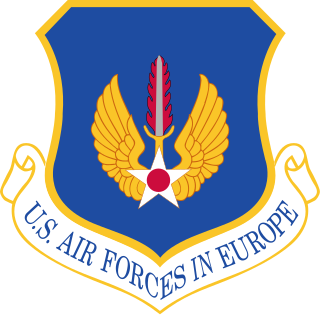
The United States Air Forces in Europe – Air Forces Africa (USAFE-AFAFRICA) is a United States Air Force (USAF) major command (MAJCOM) and a component command of both United States European Command (USEUCOM) and United States Africa Command (USAFRICOM). As part of its mission, USAFE-AFAFRICA commands U.S. Air Force units pledged to NATO, maintaining combat-ready wings based from the United Kingdom to Turkey. USAFE-AFAFRICA plans, conducts, controls, coordinates and supports air and space operations in Europe, parts of Asia and all of Africa with the exception of Egypt to achieve U.S. national and NATO objectives based on taskings by the two combatant commanders.

Electronic Attack Squadron 135 (VAQ-135), known as the "Black Ravens", is a United States Navy electronic attack squadron that currently operates the EA-18G Growler carrier-based electronic warfare jet aircraft. The squadron is permanently stationed at Naval Air Station Whidbey Island with a radio callsign of "Thunder".

The AGM-130 was an air-to-ground guided missile developed by the United States of America. Developed in 1984, it is effectively a rocket-boosted version of the GBU-15 bomb. It first entered operational service on 11 January 1999, and was retired in 2013. 502 were produced.
The Grumman F-14 Tomcat has served with the United States Navy and the Imperial Iranian Air Force, then the Islamic Republic of Iran Air Force after 1979. It operated aboard U.S. aircraft carriers from 1974 to 2006 and remains in service with Iran. In-depth knowledge of its service with Iran is relatively limited.

Operation Southern Watch was an air-centric military operation conducted by the United States Department of Defense from August 1992 to March 2003.
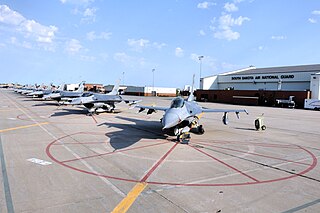
The 114th Fighter Wing is a unit of the South Dakota Air National Guard, stationed at Joe Foss Field Air National Guard Station, Sioux Falls Regional Airport, Sioux Falls, South Dakota. If activated to federal service, the Wing is gained by the United States Air Force Air Combat Command.

The 419th Fighter Wing is an Air Reserve Component (ARC) unit of the United States Air Force. It is assigned to the Tenth Air Force, Air Force Reserve Command, and is stationed at Hill Air Force Base, Utah.

The 124th Fighter Wing is a unit of the Idaho Air National Guard, stationed at Gowen Field Air National Guard Base, Boise, Idaho. It operates the Fairchild Republic A-10 Thunderbolt II aircraft conducting close air support missions. If activated to federal service, the Wing is gained by the United States Air Force Air Combat Command.

The 187th Fighter Wing is a unit of the Alabama Air National Guard, assigned to Dannelly Field, Alabama. If activated to federal service in the United States Air Force, the 187 FW is operationally gained by the Air Combat Command (ACC).

The Virginia Air National Guard (VA ANG) is the aerial militia of the Commonwealth of Virginia, United States of America. It is a reserve of the United States Air Force and along with the Virginia Army National Guard an element of the Virginia National Guard of the much larger United States National Guard Bureau.

The 23d Fighter Squadron is an inactive United States Air Force unit. It was last assigned to the 52d Operations Group and stationed at Spangdahlem Air Base, Germany. It was inactivated on 13 August 2010.
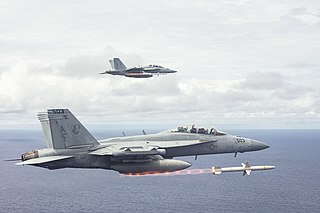
Electronic Attack Squadron 209 (VAQ-209) is a United States Navy Reserve electromagnetic attack squadron. Known as the "Star Warriors", the squadron flies the EA-18G Growler carrier-based electronic warfare jet aircraft. It is assigned to the Tactical Support Wing and based at Naval Air Station Whidbey Island, Washington. Its mission is: "To safely train to attain and maintain mobilization readiness for immediate employment in event of war or national emergency." The squadron's radio callsign is "Vader".
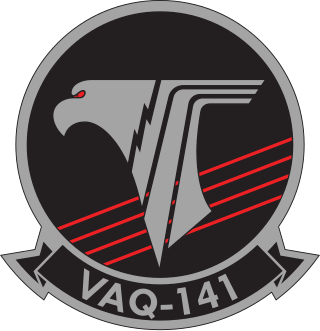
Electromagnetic Attack Squadron 141 (VAQ-141), also known as the "Shadowhawks", is an EA-18G Growler squadron of the United States Navy that is based at Marine Corps Air Station Iwakuni, located in Iwakuni, Yamaguchi, Japan. VAQ-141 falls under the cognizance of Commander, Electromagnetic Attack Wing Pacific (COMVAQWINGPAC) and flies in support of Carrier Air Wing 5 (CVW-5) aboard the Nimitz-class aircraft carrier, USS Ronald Reagan (CVN-76).
During the 1991 Gulf War and subsequent operations in no-fly zones over Iraq, Coalition air forces faced the Iraqi Air Force (IQAF), the fourth largest air force in the world at the time. In the opening days of the war, many air-to-air engagements occurred, between Iraqi interceptors and a variety of different Coalition aircraft.

During January 1993, numerous coalition airstrikes occurred against Iraq in response to actions by the latter predominantly due to the No-Fly Zone in Southern Iraq.
















